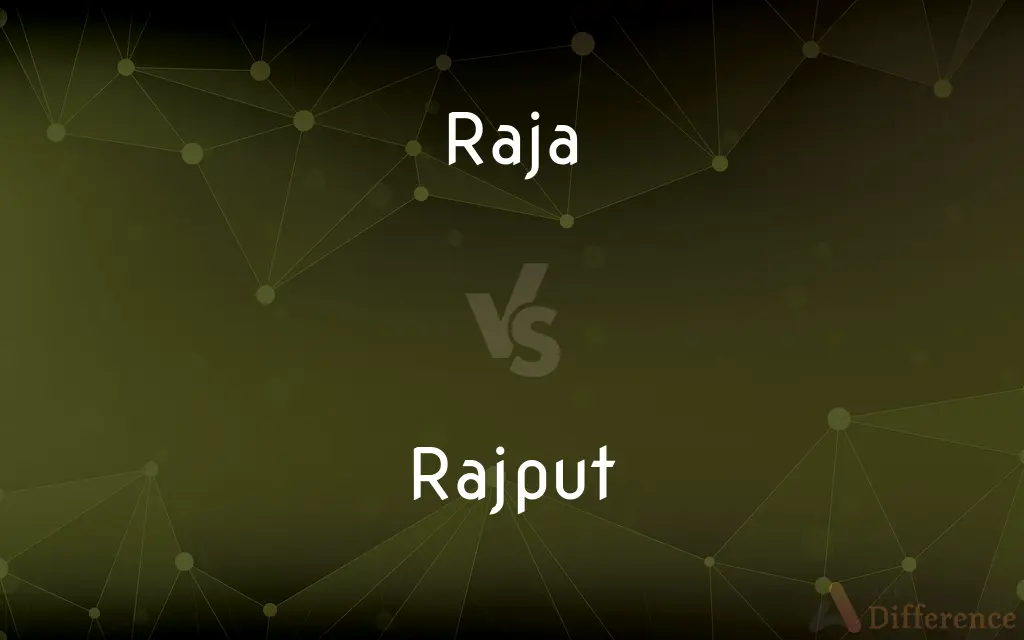Raja vs. Rajput — What's the Difference?
Edited by Tayyaba Rehman — By Maham Liaqat — Updated on March 11, 2024
Raja refers to a king or prince in India, symbolizing sovereign authority, while Rajput denotes a member of a patrilineal clan known for their martial prowess in Indian history.

Difference Between Raja and Rajput
Table of Contents
ADVERTISEMENT
Key Differences
Raja historically denotes a monarch or princely ruler in the Indian subcontinent, holding sovereign power over a region. These figures were often central to the governance and cultural patronage of their domains, embodying the apex of political authority and social hierarchy. Rajputs, on the other hand, belong to a specific warrior class within the Indian subcontinent, known for their valiance, military prowess, and adherence to the code of conduct known as Kshatriya dharma. Originating from various North Indian regions, they played a crucial role in defending their kingdoms and maintaining the social order.
While rajas were recognized for their administrative capabilities, diplomatic relations, and contributions to cultural developments, Rajputs were distinguished by their commitment to bravery, loyalty, and martial traditions. This distinction emphasizes the difference between the roles of governance and military leadership within the societal structure of ancient and medieval India.
Rajas often commanded expansive territories, wielding absolute or near-absolute authority over their realms, engaging in diplomacy, and fostering economic growth. Conversely, Rajputs were typically vassals or military commanders under the aegis of a raja or a similar authority, tasked with protecting the realm and expanding its territories through warfare.
In the context of lineage and inheritance, rajas belonged to royal families, where the title and power were usually hereditary, passed down through generations. Meanwhile, Rajputs constituted a broader class of nobility, where lineage was equally crucial, but the emphasis was more on martial lineage and the perpetuation of warrior values across generations.
Rajas played a pivotal role in patronizing arts, literature, and architecture, contributing to the rich tapestry of Indian cultural heritage. In contrast, Rajputs are celebrated in folklore and history for their chivalry, heroic battles, and enduring legacy in the form of forts, palaces, and tales of valor, underlining the martial ethos that characterized their contribution to Indian culture.
ADVERTISEMENT
Comparison Chart
Definition
A monarch or prince in India.
A member of a warrior clan in India.
Role
Governance, diplomacy, cultural patronage.
Military leadership, protection of realms.
Lineage
Royal families, hereditary titles.
Warrior nobility, martial lineage.
Contribution
Cultural development, economic growth.
Valor, chivalry, martial prowess.
Historical Context
Centralized authority, kingdom governance.
Feudal structure, clan-based society.
Compare with Definitions
Raja
In historical contexts. refers to rulers with significant autonomy.
Many Rajas maintained their kingdoms despite external pressures.
Rajput
A member of the Kshatriya warrior class.
The Rajput warriors were renowned for their bravery.
Raja
Represents the apex of traditional Indian social hierarchy.
The Raja played a key role in regional politics.
Rajput
Symbolizes chivalry and valor in Indian culture.
Tales of Rajput heroism are part of folk traditions.
Raja
A hereditary monarch of Indian states.
The Raja of Jodhpur was known for his progressive policies.
Rajput
Denotes lineage to a martial clan.
Being a Rajput meant adhering to a strict code of honor.
Raja
A title used for Indian sovereigns.
The Raja patronized the arts extensively during his reign.
Rajput
Known for their role in medieval Indian battles.
Rajput kingdoms were pivotal in resisting invasions.
Raja
Symbolic of royal authority in India.
The Raja's decree was final in the kingdom.
Rajput
Reflects a distinct identity within the Indian nobility.
The Rajputs held significant power in regional politics.
Raja
A prince, chief, or ruler in India or the East Indies.
Rajput
Rajput (from Sanskrit raja-putra, "son of a king") is a large multi-component cluster of castes, kin bodies, and local groups, sharing social status and ideology of genealogical descent originating from the Indian subcontinent. The term Rajput covers various patrilineal clans historically associated with warriorhood: several clans claim Rajput status, although not all claims are universally accepted.
Raja
Raja (; from Sanskrit: राजन्, IAST rājan-), is a royal title used for Indian monarchs. The title is equivalent to king or princely ruler in the Indian subcontinent and Southeast Asia.
Rajput
A member of any of several powerful Hindu landowning and military lineages inhabiting northern and central India.
Raja
Alternative spelling of rajah
Rajput
A member of the dominant Hindu military caste in northern India
Raja
Same as Rajah.
Raja
A Hindu prince or king in India
Raja
Type genus of the family Rajidae
Common Curiosities
How did Rajas and Rajputs contribute to Indian society?
Rajas contributed through governance, cultural patronage, and economic development, while Rajputs are celebrated for their military prowess and chivalry.
Were all Rajas and Rajputs Hindu?
Primarily, yes, though there were exceptions, especially in regions with diverse cultural influences.
Who are Rajputs?
Rajputs are members of a warrior class in India, known for their martial traditions and noble lineage.
What distinguishes a Raja from a Rajput?
A Raja holds sovereign power and focuses on administration, whereas a Rajput is primarily involved in military roles and belongs to a warrior class.
What role did Rajputs play in warfare?
They were frontline warriors, known for their bravery and strategic military skills.
Is the Rajput identity still significant in India?
Yes, it remains a source of pride and cultural identity for their descendants and communities.
Did Rajas have absolute authority in their kingdoms?
In many cases, yes, though their power could be moderated by councils, ministers, and historical conventions.
What is a Raja?
A Raja is a king or prince in India, often ruling over a significant territory.
Are there any famous Rajput battles?
Yes, battles like those of Haldighati and Chittorgarh are legendary, showcasing Rajput bravery against formidable foes.
How are Rajas and Rajputs perceived in modern India?
Both are revered for their historical roles, with a lasting influence on Indian culture, traditions, and social structures.
How is the title of Raja inherited?
It is typically passed down hereditarily within a royal family.
Can a Rajput become a Raja?
Yes, in some cases, Rajputs ascended to become Rajas, especially if they founded their own kingdoms or were elevated through significant deeds.
What is the cultural significance of Rajas in Indian history?
Rajas are symbolic of India's rich royal heritage, having played key roles in its cultural and political development.
How did Rajputs influence Indian architecture?
They constructed numerous forts, palaces, and temples, many of which stand as architectural marvels today.
What was the societal structure in Rajput kingdoms?
It was typically feudal, with a strong emphasis on martial valor, loyalty, and hierarchical relationships.
Share Your Discovery

Previous Comparison
Cervix vs. Collum
Next Comparison
Glutin vs. GlutenAuthor Spotlight
Written by
Maham LiaqatEdited by
Tayyaba RehmanTayyaba Rehman is a distinguished writer, currently serving as a primary contributor to askdifference.com. As a researcher in semantics and etymology, Tayyaba's passion for the complexity of languages and their distinctions has found a perfect home on the platform. Tayyaba delves into the intricacies of language, distinguishing between commonly confused words and phrases, thereby providing clarity for readers worldwide.














































